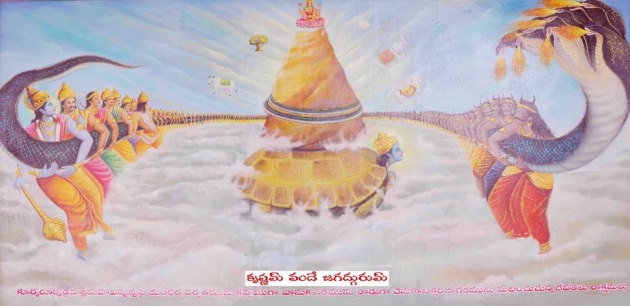Puraanaas are the fruits of the vision and selfless preachings of our sages .They are the repositories of highest wisdom explained in a lucid telltale manner. One of these episodes is connected to churning of Cosmic Milk sea by Devatas & Rakshasas for getting nectar., and the help of Lord Vishnu in doing so. This episode, as appearing in the 8th Skandha of Bhagavatam, is famous with the name “ Ksheera Sagara Madhanam”.As per our Scriptures , Kurma (Tortoise) Avataar is the second incarnation of the famous Dasa Avataaraas of Lord Sri Maha Vishnu.The message of Kurma Avataar, is that of timely divine help to seekers after they put in their best efforts in attaining/regaining Glory.It took place in the Solar Planetary system during the sixth Manu of Varaaha Kalpa – Chakshusha.
During Kruta Yuga of 28th Maha Yuga of Seventh Manu – Vaivaswata, Lord Sri Maha Vishnu remanifested in Srikurmam (A.P.,India) in Kurma Avataar Form. Legend Says that during Kruta (Satya) Yuga, A Pious King – SWETA MAHARAJ , observed fierce Penance for many years. Fulfilling his wish, LORD VISHNU manifested (Swayambhu) here in the form of Kurma Avataar. LORD BRAHMA, the creator of Universe, himself officiated the celestial rituals and consecrated the shrine with Gopaala Yantra .Since Kurmanadha is the controlling deity for Saturn, Devotees believe to be relieved of all Sani Doshas with Darshan at the Temple.
This ancient shrine is believed to be prior to the Golden era of SRI RAAMA (Raama Raajyam). For thousands of years, the temple is in the Pilgrimage list of devotees from all over. It has many prominent Features making SriKurmam a world reknowned, sacred shrine. A few of them are
1. More than a Million Year old Shrine where Outer Structures were constructed many a time, after dilapidation of previous one, the present one being more than 700 years old.
2. References in Kurma, Vishnu, Padma, Brahmaanda Puranaas.
3. Only Swayambhu Temple in the World where Maha Vishnu is adored in the form of Kurma (Tortoise) Avataar – 2nd Incarnation of the Famous Dasa Avataaraas of Lord Vishnu.
4. One of the few Temples in the World with 2 Dwaja Stambhaas – the second one in the west since deity is facing West.
5. One of the few Vishnu Temples in the World where Abhishekham is performed on daily basis (Like in Siva Temples).
6. One of the Few Temples in the World with centuries old rare Mural Paintings similar to those in Ajanta Ellora Caves.
7. Second Temple in the World with Durga Mata in Vaishno Devi Form., the other being in Vaishno Devi Temple, Jammu & Kashmir State.
8. Stone Sculpture at its Peak – Called Gaandharva Shilpa Kala. 108 exquisitely carved stone pillars where no pillar is similar to the other. Under ground Tunnel to Varanasi (KAASI).
9. Moksha Sthaanam where last rites are performed for deceased , like in Varanasi (U.P.State) / Puri (Odisha State)
10. Visited by many great Kings and Saints including Lava & Kusha, Bala Raama, Sage Durvaasa, Adi Sankaracharya,Ramanujacharya,Narahari Teertha, Chaitanya Maha Prabhu etc
Unlike many other Temples ,the presiding deity here is facing west and hence there are two “DWAJA STAMBHAAS” (Flag Posts) in east and west directions. This is also the reason to permit devotees to enter the “GARBHA GRUHA” (Sanctum Sanctorum) for a closer darshan of the LORD.
“SWETA PUSHKARINI” – The Lake in front of the Temple, is formed by the SUDARSHAN CHAKRA. Sri Mahaa Laxmi (the consort of Lord Vishnu),emanated from this lake and is adored in the name of SRI KURMA NAAYAKI, in Varadaa Mudra Posture seated on Garuda Vaahana. Sri Kurmam shrine is believed to be the “MOKSHA STHAANAM” and that the Sweta Pushkarini has cosmic cleansing powers. So, like in Varanasi,people perform the last rites of the deceased and drop the Asthikaas in it (Ashes Nimajjan), which eventually metamorphose into Saalagraamaas (Divine Stones). Even mother Ganga takes a bath in this lake every year on Maagha Shudha Chaviti (Around February) to cleanse herself of all the sins left by the devotees .
The Prasaadam of the Lord is said to possess mystic curative powers – After taking this, the celestial dancer “Tilottama” became devotional and renunciated Desires.,King Subhaanga won the war., a devotee by name Vaasu Deva got Leprosy cured.
This Temple is known for its marvelous sculpture, particularly on Eastern & Southern Entrances, apart from the 108 pillars, where no single pillar is similar to the remaining. The unique stones on the floor in the Pradakshina Mandapam (Circumambulatory passage)are said to infuse magnetic energy into the devotees through their feet. The ancient pictures on these walls, made from natural Vegetable colours, resemble those in AJANTA – ELLORA CAVES. “KAASI DWARAM” – the under ground tunnel to Varanasi in north eastern corner of the Pradakshina Mandapam is another magnificent piece of ancient engineering skills. The entry is closed now, since many wild animals and snakes were entering the Temple.
To protect this Temple from the Foreign invaders during 14TH – 15TH centuries , like in many Temples in South India, the locals applied Lime Stone Mix on the entire Temple complex and camouflaged as a hillock. The solidified lime stone layers are still being peeled off now, and the same are visible even today on the Temple Walls. Temples are the pivots of Hindu culture. Many of our fore fathers sacrificed their lives to protect these invaluable Treasures for Posterity. With only 3 of the 29 ancient civilizations remaining, and Hinduism being one of them, the present generation has the inescapable responsibility to protect, if not further develop, and pass on to the next generations. As the great sages said “CONSERVE THE NATURE – PRESERVE THE CULTURE – TO DESERVE A FUTURE”. What is required is nerves of steel to spread this message with a missionary Zeal.


No comments:
Post a Comment